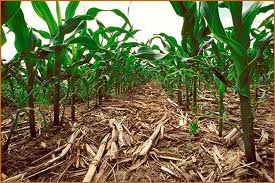Soil erosion is still the most important form of soil degradation in Pennsylvania. More than half of our cropland is classified as Highly Erodible Land so conservation measures are necessary to keep topsoil on the field and avoid the loss of soil productivity. In addition, soil erosion harms the quality of our streams and water bodies by clouding the water and carrying excessive amounts of nutrients that cause algal blooms. No-till planting can greatly reduce the amount of soil erosion occurring on your farm. This practice leaves more than 30% of the soil surface covered by crop residue which protects the soil from the erosive energy of rain and runoff.
Benefits of No Tillage
Environmental: Leaving residue on the surface greatly reduces the amount of exposed soil that can be eroded during rain events. The residue mulch can also help reduce drought stress by increasing water infiltration and reducing evaporation from the soil surface. By leaving the plant material to decompose slowly on the surface, soil organic matter content and nutrient cycling are improved.
Economic: No tillage can make crop production more profitable and efficient by eliminating the work necessary to prepare the fields for planting. Equipment, fuel, and labor costs can be reduced through the use of this practice, and timeliness of operations improves.
Tips For Using No-Till
* Continuous use of no-till is the only way of improving near-surface soil tilth and organic matter content and improving soil bearing capacity so avoid ‘rotational tillage’.
* No-till is a system in which crop diversity and cover crops play important roles. Monoculture and periods without living vegetation should be avoided to reap the benefits of no-till.
* No-till is not a cure-all. Other practices such as contour farming, strip cropping and grassed waterways still have a place, especially to avoid gully formation in areas of concentrated flow.
Programs
USDA NRCS
USDA NRCS administers a variety of cost share programs to implement conservation practices such as no-till. The Conewago is USDA’s “Showcase Watershed” meaning the watershed is targeted for resources and funding.
319 Funding
Farms in priority areas of the watershed may be eligible for funding through the County Conservation Districts’ 319 funding.
BMP Challenge
American Farmland Trust offers compensation for any yield loss resulting from producers’ transition from conventional tillage to no-till.
Interested in implementing this practice?
Contact:
Heather Grove, USDA NRCS
(717) 874-2530, heather.grove@pa.usda.gov
Eric Naguski, DCCD
(717) 921-8100, enaguski@dauphinc.org
Web Resources
Steps Toward a Successful Transition to No-Till-
https://extension.psu.edu/no-till-crop-management-tips
https://extension.psu.edu/planter-performance-in-no-till

